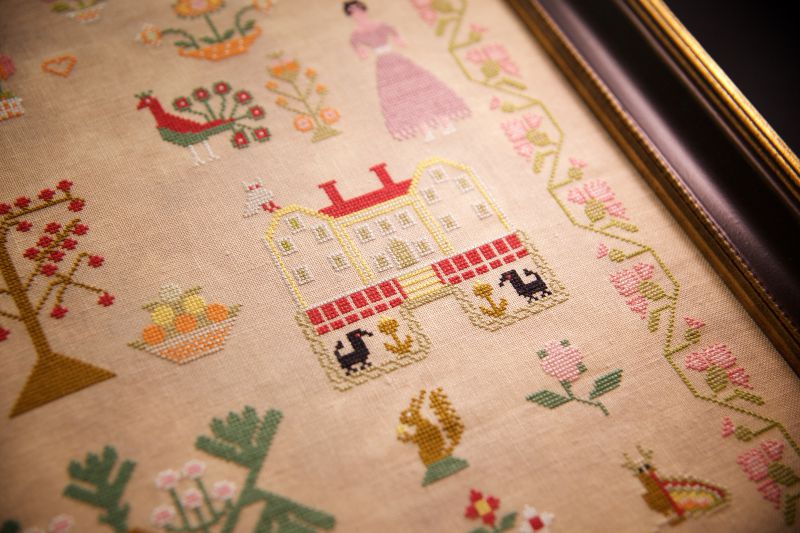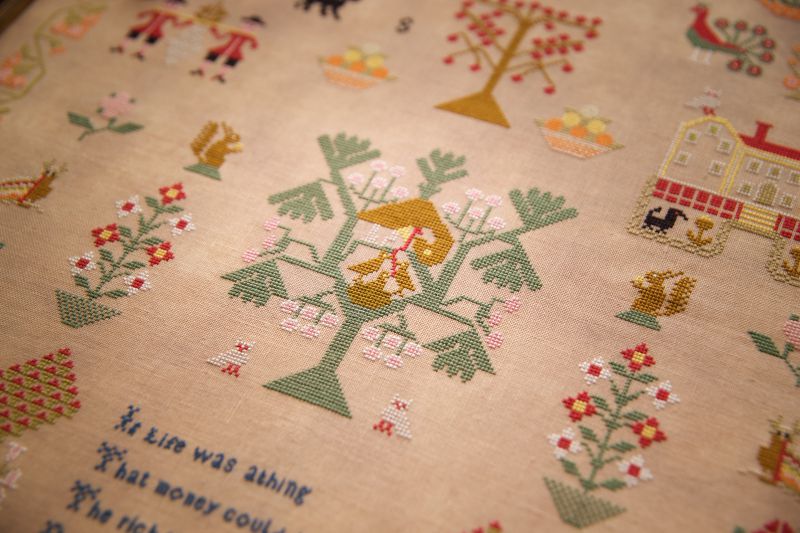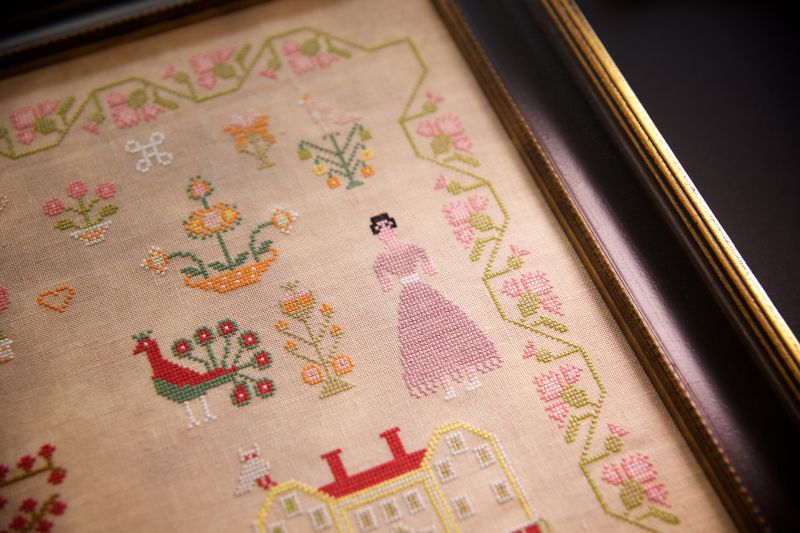Hands Across the Sea - Eliza Johnson 1828
- Brand: Hands Across the Sea Samplers
- Product Code:
- Availability: In Stock
-
$56.95

When we first saw Eliza’s pretty sampler, we were both excited, intrigued, and puzzled. Eliza tells us that she was 13 when she finished her sampler on June 12, 1828 which was a Thursday. George IV sat upon the British throne, he was considered to be “The First Gentleman of Europe” and an object of contempt and ridicule. He was known for his manners and charm but also his drunkenness, spendthrift ways, and scandalous love life.
Eliza chose a very fine material called “tiffany fabric” to stitch her sampler. Tiffany fabric is often used on darning samplers. The fine linen had become fragile over the years, and her sampler was stabilised and conserved some years ago. We were unable to access the reverse of her sampler to view the colours without causing damage. Therefore, we have reproduced Eliza with the beautiful oranges, pinks, and greens we see on the front of her sampler today.

Within her pretty carnation border, there are certain motifs that you only occasionally see in English and Scottish samplers. The Pelican in its Piety takes centre stage and keeps company with The Spies of Canaan, two young ladies dressed in pink “to make the boys wink”, and a manor house with two terriers keeping a lookout. Eliza was certainly imaginative and filled her sampler with an assortment of motifs, including a solitary large black dog, two strutting peacocks, two mischievous squirrels, two resting deer, two parrots, two owls, baskets of fruit, several varieties of flowers in baskets, a tree laden with tempting red apples, a crown, a lion and a unicorn. There are several motifs that suggest Eliza Johnson was Scottish.
The Pelican in its Piety is a motif of a mother bird feeding her fledglings that we usually see in Dutch and German samplers. A renowned English sampler that features the motif is Jane Bostock, which was worked in 1598. This is the earliest dated sampler that has survived, and it is in the collection of the Victoria and Albert Museum in London. The motif “Ce Pelican” can be found in a 1587 needlework pattern book by Federico de Vinciolo, a pattern designer and lace maker from Venice who worked at the court of Henry II of France. The Pelican piercing its breast to feed its young with its blood became a popular symbol of the sacrifice of Christ during the late medieval and early Renaissance period. It can also be found on many kinds of sculptures, manuscripts, stained glass windows, and church carvings, and church vestments.

The unicorn that Eliza has stitched has long been associated with Scotland, a land famed for its deep history of myths and legends. The unicorn was first used on the Scottish royal coat of arms by William I in the 12th century. In the 15th century, when King James III was on the throne, unicorns appeared on gold coins. When Scotland and England unified under the reign of James VI of Scotland in 1603, the Scottish Royal Arms had two unicorns supporting a shield. When James VI became James I of England and Ireland, he replaced the unicorn on the left of the shield with a lion, the national animal of England to show that the countries were indeed united.
Eliza chose the following verse for her sampler.
If life was a thing
That money could buy
The rich they would live
But the poor they would die.
These words can be found on many old gravestones in Britain. One such gravestone from 1798 can be found in the village of Tysoe, Warwickshire. It records the full verse.
The World is a round place,
Full of crooked streets,
Death is the market-place,
Where all men meet
If life were a thing that money could buy
The rich man would live, and the poor man would die.
Today, Eliza is remembered through the needlework she wrought as a child. We wonder what she would think of the world today!
Thread Legend
The sampler has been reproduced with Au Ver à Soie d’Alger silks and the skein quantities calculated based on 1 strand on 36ct fabric. We have provided conversions for DMC based on 36ct with 2 strands and Au Ver à Soie 100.3 on 46ct with 1 strand. The linen used was Lakeside Linen in Vintage Pearl Barley.
Soie d’Alger / Soie 100.3 / DMC ~ Colour Description
121 / 002 / 3756 ~ Baby blue ~ ultra very light
526 / 616 / 829 ~ Golden olive ~ very dark
622 / 240 / 744 ~ Yellow ~ pale
1012 / 176 / 224 ~ Shell pink ~ very light
1021 / 607 / 225 ~ Shell pink ~ ultra very light
1446 / 313 / 311 ~ Navy blue ~ medium
1844 x 2 / 108 / 3363 x 2 ~ Pine green ~ medium
2623 / 665 / 922 ~ Copper ~ light
2922 / 500 / 816 ~ Garnet
2931 / 278 / 761 ~ Salmon ~ light
2932 / 494 / 760 ~ Salmon
3011 / 076 / 3716 ~ Dusty rose ~ very light
3341 / 401 / 3866 ~ Mocha brown ~ ultra very light
3432 / 341 / 543 ~ Beige brown ~ ultra very light
3733 x 2 / 152 / 370 x 2 ~ Mustard ~ medium
3833 / 603 / 371 ~ Mustard
Blanc / Blanc / 3865 ~ Winter white
4116 / 508 / 433 ~ Brown ~ medium
4532 / 562 / 613 ~ Drab brown ~ very light
4633 / 124 / 316 ~ Antique mauve ~ medium
Noir / Noir / 310 ~ Black
LINEN SIZES
The design area is 301 stitches (w) x 393 stitches (h). Our calculations have included a 3″ margin for finishing and framing.
28ct ~ Design: 21.5″ x 28.07″ Fabric: 27.5″ x 34.07″ 32ct ~ Design: 18.81″ x 24.56″ Fabric: 24.81″ x 30.56″
36ct ~ Design: 16.72″ x 21.83″ Fabric: 22.72″ x 27.83″ 40ct ~ Design: 15.05″ x 19.65″ Fabric: 21.05″ x 25.65″
46ct ~ Design: 13.09″ x 17.09″ Fabric: 19.09″ x 23.09″ 56ct ~ Design: 10.75″ x 14.04″ Fabric: 16.75″ x 20.04″
Tags: Hands Across the Sea

